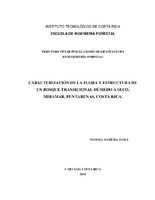Mostrar el registro sencillo del ítem
Caracterización de la flora y estructura de un bosque transicional húmedo a seco, Miramar, Puntarenas Costa Rica
| dc.contributor.author | Zamora-Ávila, Massiel | |
| dc.date.accessioned | 2013-02-26T19:14:29Z | |
| dc.date.available | 2013-02-26T19:14:29Z | |
| dc.date.issued | 2011 | |
| dc.identifier.uri | https://hdl.handle.net/2238/3017 | |
| dc.description | Proyecto de Graduación (Licenciatura en Ingeniería Forestal) Instituto Tecnológico de Costa Rica, Escuela de Ingeniería Forestal, 2010. | |
| dc.description.abstract | Mangroves are ecosystems with high ecological, economical and environmental value. They are essential in the life cycle of many species of wildlife. Stabilize coastal soils and highlight among other types of forests, because of their capacity to storage carbon in large quantities. The objectives were to delimit the area, assess the horizontal and vertical structure, analyze the floristic composition and quantify above- ground biomass and carbon, according to the distance gradient from the edge of the channel, in two Southern Caribbean mangroves of Costa Rica. Circular seven meters radius plots were established arranged every 25 m, on transects perpendicular to the edge of the channel,. We assessed the diameter, tree density, basal area, diameter class distribution of individuals, total height and trees density per height storey, importance value index of species (IVI), diversity index, above-ground biomass and carbon. We used an incomplete random block design (IRBD). Variance analysis (ANOVA) and Duncan tests were performed. The mangrove area in Gandoca is 13,34 and 10,73 ha in Moín. The structural variables are similar to others reported for mangroves in the Caribbean and indicate that the studied mangroves are mature and are in constant renewal; however Moín shows some disturbance. In Gandoca and Moín the individuals were average diameters between 21,43 and 20,01 cm, total height average of 12,8 and 10,5 m, tree density was 687 and 708 trees/ha, basal area was 26,35 and 26,37 m2/ha, respectively. The most important specie was Rhizophora mangle in Gandoca and Pterocarpus officinalis in Moín. In both sites are also Laguncularia racemosa and Avicennia germinans with 20 other associated species. The most diverse site was Moín. The biomass and carbon stocks are higher than those reported for secondary and primary forests of Costa Rica and other mangroves of the Indo - Pacific. The biomass was 330, 27 and 257,10 Mg/ha and the carbon was 183,47 and 237,36 Mg/ha, for Gandoca and Moín respectively. The analyzed variables showed significant differences over 110m away from the edge of the channel, in the case of Gandoca, and showed no differences in the distances analyzed in the Moín mangrove. | en |
| dc.language.iso | es | es_CR |
| dc.publisher | Instituto Tecnológico de Costa Rica. Escuela de Ingeniería en Forestal | es |
| dc.rights | acceso abierto | es |
| dc.subject | Composición florística | es_CR |
| dc.subject | Estructura vertical | es_CR |
| dc.subject | Estructura horizontal | es_CR |
| dc.subject | Bosque transicional | es_CR |
| dc.subject | Diversidad | es_CR |
| dc.subject | Especies | es_CR |
| dc.subject | Mangroves | en |
| dc.subject | Carbon Storage | en |
| dc.title | Caracterización de la flora y estructura de un bosque transicional húmedo a seco, Miramar, Puntarenas Costa Rica | es_CR |
| dc.type | proyecto fin de carrera | es_CR |


